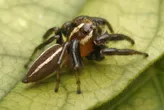Harmful Effects of Phidippus pulcherrimus
A species of Phidippus
Phidippus pulcherrimus poses minimal health risks to humans, with rare instances of bites occurring when threatened. Transmission is through a defensive bite, causing mild irritation or localized reactions, not life-threatening and usually not requiring medical treatment.
Is the Phidippus pulcherrimus poisonous?
Does the Phidippus pulcherrimus bite humans or animals?
Harmful Facts About Phidippus pulcherrimus









AI entomologist in your pocket
Scan QR code to download

